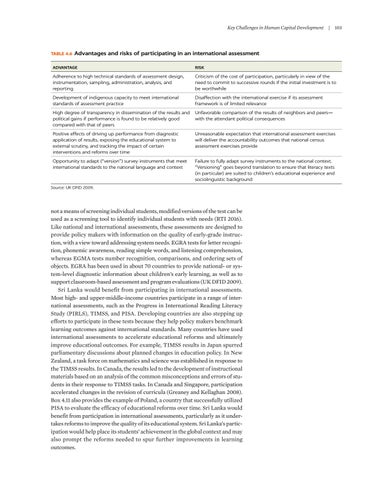Key Challenges in Human Capital Development | 103
TABLE 4.6 Advantages
and risks of participating in an international assessment
ADVANTAGE
RISK
Adherence to high technical standards of assessment design, instrumentation, sampling, administration, analysis, and reporting
Criticism of the cost of participation, particularly in view of the need to commit to successive rounds if the initial investment is to be worthwhile
Development of indigenous capacity to meet international standards of assessment practice
Disaffection with the international exercise if its assessment framework is of limited relevance
High degree of transparency in dissemination of the results and political gains if performance is found to be relatively good compared with that of peers
Unfavorable comparison of the results of neighbors and peers— with the attendant political consequences
Positive effects of driving up performance from diagnostic application of results, exposing the educational system to external scrutiny, and tracking the impact of certain interventions and reforms over time
Unreasonable expectation that international assessment exercises will deliver the accountability outcomes that national census assessment exercises provide
Opportunity to adapt (“version”) survey instruments that meet international standards to the national language and context
Failure to fully adapt survey instruments to the national context. “Versioning” goes beyond translation to ensure that literacy texts (in particular) are suited to children’s educational experience and sociolinguistic background
Source: UK DFID 2009.
not a means of screening individual students, modified versions of the test can be used as a screening tool to identify individual students with needs (RTI 2016). Like national and international assessments, these assessments are designed to provide policy makers with information on the quality of early-grade instruction, with a view toward addressing system needs. EGRA tests for letter recognition, phonemic awareness, reading simple words, and listening comprehension, whereas EGMA tests number recognition, comparisons, and ordering sets of objects. EGRA has been used in about 70 countries to provide national- or system-level diagnostic information about children’s early learning, as well as to support classroom-based assessment and program evaluations (UK DFID 2009). Sri Lanka would benefit from participating in international assessments. Most high- and upper-middle-income countries participate in a range of international assessments, such as the Progress in International Reading Literacy Study (PIRLS), TIMSS, and PISA. Developing countries are also stepping up efforts to participate in these tests because they help policy makers benchmark learning outcomes against international standards. Many countries have used international assessments to accelerate educational reforms and ultimately improve educational outcomes. For example, TIMSS results in Japan spurred parliamentary discussions about planned changes in education policy. In New Zealand, a task force on mathematics and science was established in response to the TIMSS results. In Canada, the results led to the development of instructional materials based on an analysis of the common misconceptions and errors of students in their response to TIMSS tasks. In Canada and Singapore, participation accelerated changes in the revision of curricula (Greaney and Kellaghan 2008). Box 4.11 also provides the example of Poland, a country that successfully utilized PISA to evaluate the efficacy of educational reforms over time. Sri Lanka would benefit from participation in international assessments, particularly as it undertakes reforms to improve the quality of its educational system. Sri Lanka’s participation would help place its students’ achievement in the global context and may also prompt the reforms needed to spur further improvements in learning outcomes.




